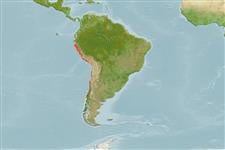Common names from other countries
Environment: milieu / climate zone / depth range / distribution range
Ecologia
; intervalo de profundidade 0 - 500 m (Ref. 356). Tropical, preferred 20°C (Ref. 107945); 5°S - 42°S, 81°W - 70°W (Ref. 106891)
Southeast Pacific: From Paita, Peru to Chiloé, Chile. Tropical to subtropical.
Length at first maturity / Tamanho / Peso / Idade
Maturity: Lm ? range ? - ? cm Max length : 12.0 cm ShL macho/indeterminado; (Ref. 356)
Found in shallow bays (Ref. 106891). Inhabits sedimentary grounds in sheltered areas at depths from 5 to 40 m (Ref. 106862).
Life cycle and mating behavior
Maturidade | Reprodução | Desova | Ovos | Fecundidade | Larvas
Life cycle: Embryos develop into free-swimming trocophore larvae, succeeded by the bivalve veliger, resembling a miniature clam (Ref. 833). Spawning occurs year-round but mainly during spring and autumn (Ref. 106788).
SAUP Database. 2006. (Ref. 356)
Status na Lista Vermelha da IUCN (Ref. 130435)
Status no CITES (Ref. 108899)
Not Evaluated
Not Evaluated
Uso pelos humanos
Pescarias: espécies comerciais; Aquacultura: espécies comerciais
FAO - Aquacultura: produção; pescarias: landings | FishSource | Sea Around Us
Ferramentas
Fontes da internet
Estimates based on models
Resiliência
Elevada, tempo mínimo de duplicação da população menor que 15 meses (K=1.99-2.88).
Vulnerabilidade
Low vulnerability (10 of 100).
